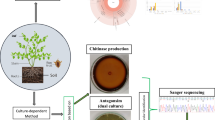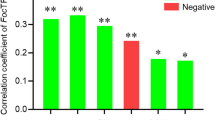Abstract
The anamorphic fungus Sporothrix inflata, known as a soil-borne fungus with worldwide distribution, was isolated for the first time from the cortex and central cylinder of living and dead roots of healthy and diseased oak trees (Quercus robur and Q. petraea). Isolation frequencies of S. inflata from oak roots varied according to the health status of trees, oak species, study sites, soil depth and root diameter. Colony morphology and growth rate of isolates are influenced by colony age and type of culture medium.
Similar content being viewed by others
References
Bakshi BK (1951) Studies on four species of Ceratocystis, with a discussion on fungi causing sap-stain in Britain. — Mycological Papers 35: 1–16.
Bartnik C (1997) [Disease symptoms and damages in roots of declined oaks and accompanying fungi.] In Majewski M (ed) Materialy sympozjum „Fitopatologia wczoraj, dzi i jutro“, pp. 3–8. Warszawa, Agencja Exit (in Polish)
Bavendamm W (1928) Über das Vorkommen und den Nachweis von Oxydasen bei holzzerstörenden Pilzen. — Zeitschrift für Pflanzenkrankheiten 38: 257–276.
Bertoldi M de, Lepidi AA, Nuti MP (1972) Classification of the genus Humicola Traaen. I. Preliminary reports and investigations. — Mycopathologia et Mycologia applicata 46: 289–304.
Cech T (1991) Species of Ceratocystis isolated from declining oaks in Austria and their probable pathogenicity. In Siwecki R, Liese W (eds) Oak decline in Europe, pp. 113–116. Polish Academy of Sciences, Institute of Dendrology, Kórnik, Poland.
Davidson RW, Hinds TE, Toole ER (1964) Two new species of Ceratocystis from hardwoods. — Mycologia 56: 793–798.
Delatour C, Morelet M (1991) Current research on oak decline in France, especially on Ophiostomatales. In Siwecki R, Liese W (eds) Oak decline in Europe, pp. 89–92. Polish Academy of Sciences, Institute of Dendrology, Kórnik, Poland.
Domsch KH, Gams W, Anderson TH (1980) Compendium of soil fungi I, II. Academic Press, London.
Fisher PJ, Petrini O, Petrini LE (1991) Endophytic ascomycetes and deuteromycetes in roots of Pinus sylvestris. — Nova Hedwigia 32: 11–15.
Guseinov ES (1984) [Vascular dieback of oaks in Azerbaijan.] — Mikologiya i Fitopatologiya 18: 144–149 (in Russian)
Hager H (1993) Das Programm zur Erforschung der Eichenerkrankungen in Österreich und einige vorläufige Ergebnisse. In: Zustand und Gefährdung der Laubwälder. Rundgespräche der Kommission für Ökologie 5, pp. 69–80. Verlag Dr. Friedrich Pfeil, München.
Halmschlager E (1991) Endophytische Pilze in Blättern, Zweigen und Knospen der Traubeneiche (Quercus petraea [Matt.] Lieb.). Ph.D. Thesis, University of Agricultural Sciences, Vienna.
Halmschlager E (1998) The possible role of Armillaria spp. and Phytophthora spp. in the oak decline complex. Preliminary results from a three-year survey on two declining oak stands in eastern Austria. In Cech T, Hartmann G, Tomiczek C (eds) Disease/Environment Interactions in Forest Decline, pp. 49–56. Proceedings International IUFRO-Workshop, Federal Forest Research Center, Vienna, Austria.
Halmschlager E, Kowalski T (1998) Inventur der phytopathogenen, endophytischen und saprophytischen Mykoflora im Wurzelbereich gesunder und geschädigter Eichen. BMWV Research Report, Institute of Forest Entomology, Forest Pathology and Forest Protection, University of Agricultural Sciences, Vienna.
Halmschlager E, Kowalski T (2000) Ticogloea guttulata — the first record from oak and the third report world-wide. — Austrian Journal of Mycology 9: 67–73.
Halmschlager E, Messner R, Kowalski T, Prillinger H (1994) Differentiation of Ophiostoma piceae and Ophiostoma quercus by morphology and RAPD analysis. — Systematic and Applied Microbiology 17: 554–562.
Harrington TC (1981) Cycloheximide sensitivity as a taxonomic character in Ceratocystis. — Mycologia 73: 1123–1129.
Hektoen L, Perkins CF (1909) Refractory subcutaneous abscesses caused by Sporothrix schenckii, a new pathogenic fungus. — Journal of Experimental Medicine 5: 77–89.
Holdenrieder O, Sieber TN (1992) Fungal associations of serially washed healthy non-mycorrhizal roots of Picea abies. — Mycological Research 96: 151–156.
Hoog GS de (1974) The genera Blastobotrys, Sporothrix, Calcarisporium and Calcarisporiella gen. nov. — Studies in Mycology 7: 1–84.
Hoog GS de (1993) Sporothrix-like anamorphs of Ophiostoma species and other fungi. In Wingfield MJ, Seifert KA, Webber JF (eds) Ceratocystis and Ophiostoma. Taxonomy, Ecology, and Pathogenicity, pp. 53–60. APS Press, St. Paul, MN.
Hunt J (1956) Taxonomy of the genus Ceratocystis. — Lloydia 19: 1–59.
Hydrographisches Zentralbüro (ed.) (1998) Hydrographischer Jahresbericht von Österreich 103/1995. Hydrographisches Zentralbüro des BMLF, Vienna.
Igmandy Z (1987) Die Welkeepidemie von Quercus petraea (Matt.) Lieb. in Ungarn (1978 bis 1986). — Österreichische Forstzeitung 98: 48–50.
Kirschner R (1998) Diversität mit Borkenkäfern assoziierter filamentöser Mikropilze. Dissertation, Univ. Tübingen, Fakultät für Biologie, 576 p.
Kovacs G, Pausch M, Urban A (2000) Diversity of ectomycorrhizal morphotypes and oak decline. — Phyton 40: 109–116.
Kowalski T (1983) Vorkommen von Pilzen in durch Luftverunreinigung geschädigten Wäldern im Oberschlesischen und Krakauer Industriegebiet. IX. Mykoflora von Quercus robur L. und Quercus rubra L. an einem Standort mit mittlerer Immissionsbelastung. — European Journal of Forest Pathology 13: 46–59.
Kowalski T, Bartnik C (1990) Ceratocystis species on Quercus robur L. with oak decline symptoms in Southern Poland. — EPPO Bulletin 20: 221–228.
Kowalski T, Butin H (1989) Taxonomie bekannter und neuer Ceratocystis-Arten an Eiche (Quercus robur L.). — Journal of Phytopathology 124: 236–248.
Kowalski T, Domański S (1991) Preliminary results of artificial inoculations of Quercus robur L. with different species of Ceratocystis. In Siwecki R, Liese W (eds) Oak decline in Europe, pp. 93–104. Polish Academy of Sciences, Institute of Dendrology, Kórnik, Poland.
Kryukova EA, Plotnikova TS (1979) [Vascular mycosis of oak in the south-east European part of the USSR.] — Lesnoe Khozyaistvo 1: 69–73 (in Russian).
Küppers H. (1999) DuMont’s Farbenatlas. DuMont, Köln.
Lopez SE, Nelson EE, Thies WG (1995) A new species of Botryoderma and other Hyphomycetes isolated from roots of fumigated and nonfumigated Douglas-fir stumps in Oregon. — Mycotaxon 55: 269–274.
Neumann M, Pollanschütz J (1988) Taxationshilfe für Kronenzustandserhebungen. — Österreichische Forstzeitung 99: 27–37.
Pfenning L, Oberwinkler F (1993) Ophiostoma bragantinum n. sp., a possible teleomorph of Sporothrix inflata, found in Brazil. — Mycotaxon 46: 381–385.
Przybył K. (1991) On the pathogenicity of Ophiostoma piceae. In Siwecki R, Liese W (eds) Oak decline in Europe, pp. 83–88. Polish Academy of Sciences, Institute of Dendrology, Kórnik, Poland.
Roxon JE, Jong SC (1974) A new pleomorphic species of Humicola from Saskatchewan soil. — Canadian Journal of Botany 52: 517–520.
Schume H (1992) Vegetations-und Standortkundliche Untersuchungen in Eichenwäldern des nordöstlichen Niederösterreich unter Zuhilfenahme multivariater Methoden. In Österreichische Gesellschaft für Waldökosystemforschung und experimentelle Baumforschung (ed) FIW-Forschungsberichte 1992(3), pp. 1–138. University of Agricultural Sciences, Vienna.
Tsao PH, Guy SO (1977) Inhibition of Mortierella and Pythium in a Phytophthora-isolation medium containing hymexazol. — Phytopathology 67: 796–801.
Upadhyay HP (1981) A Monograph of Ceratocystis and Ceratocystiopsis. University of Georgia Press, Athens.
Author information
Authors and Affiliations
Corresponding author
Rights and permissions
About this article
Cite this article
Halmschlager, E., Kowalski, T. Sporothrix inflata, a root-inhabiting fungus of Quercus robur and Q. petraea . Mycol Progress 2, 259–266 (2003). https://doi.org/10.1007/s11557-006-0063-2
Accepted:
Issue Date:
DOI: https://doi.org/10.1007/s11557-006-0063-2




